There are currently 51 sovereign countries in Europe, each with its own deeply symbolic flag. This article is your go-to spot for pictures and brief descriptions of each, linking in most cases to our larger dedicated articles on individual countries. How many of these flags would you know by sight?
1. Albania
The national flag of Albania shows a black two-headed eagle in the center of a red field. It comes from the seal of a 15th-century Albanian leader who fomented a rebellion against the Ottoman Empire.
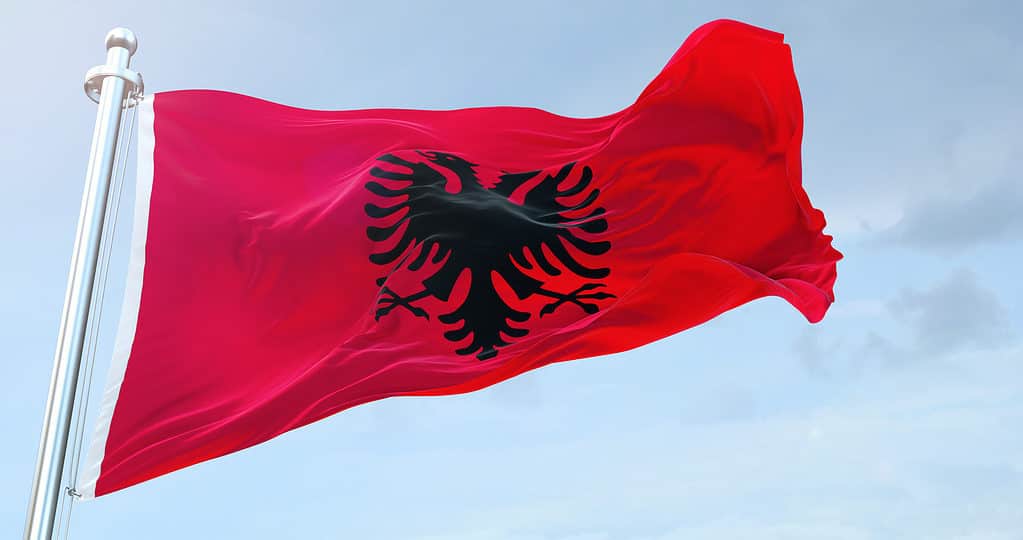
Albania’s flag includes a double-headed eagle.
©iStock.com/EA
2. Andorra
Andorra is located in the Pyrenees Mountains between France and Spain. The Andorran flag is a combination of blue, yellow, and red and features the national coat of arms in the center. The flags of its neighbors, Spain and France, inspired the design.

The flag of Andorra was inspired by French and Spanish influences.
©Gil C/Shutterstock.com
3. Armenia
The flag of Armenia was adopted after the country gained independence from the Soviet Union. The independent government chose the colors red, blue, and orange to symbolize the Armenian highlands, the struggle for freedom, the Christian faith, peace, and the creative and hardworking Armenian people.

The flag of Armenia was adopted after the country achieved independence from the Soviet Union.
©Lina Reshetnyk/Shutterstock.com
4. Austria
Austria‘s red and white striped flag was first used in the 12th century. A popular legend states that the Duke of Austria’s white coat inspired the red and white design. The coat became blood-stained during battle, leaving a white stripe when he removed his belt. It was banned during World War II when Austria was annexed by Nazi Germany but was readopted in 1945 when the war was over.

The Austrian flag flying over the historic cityscape of Salzburg.
©iStock.com/Teka77
5. Azerbaijan
The flag of Azerbaijan was first adopted in 1918 and officially re-adopted in 1991 when the country gained independence from the Soviet Union. It symbolizes Azerbaijan’s Turkic heritage (blue), progress and Europeanization (red), and Islam (green).
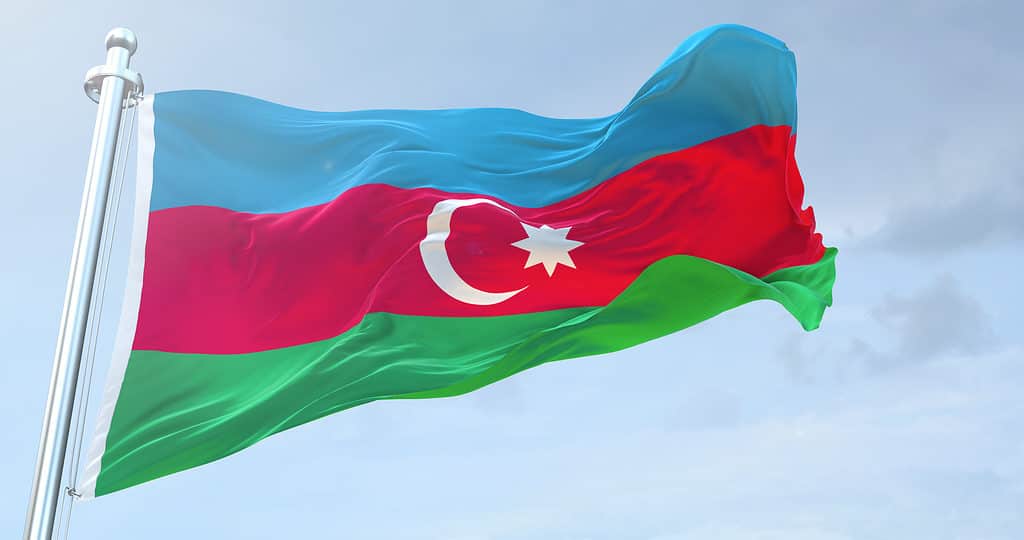
The flag of Azerbaijan honors the country’s Turkic, European, and Islamic cultural roots.
©iStock.com/EA
6. Belarus
Belarus is one of the countries that emerged from the breakup of the Soviet Union, but it has remained closely allied with Russia. The red and green color scheme carried over from the previous flag. This flag flew during its years as a republic of the Soviet Union. The intricate pattern along the hoist side in red and white is a traditional Belarussian woven fabric pattern.

The intricate pattern on the hoist side of the Belarussian flag is a traditional woven fabric pattern.
©M_Videous/Shutterstock.com
7. Belgium
Belgium was a part of the Netherlands until it successfully won an independence struggle in 1830. The flag of France inspired the vertical tricolor design. The colors black and gold are the colors of the region where the revolution began. Red complements these colors in order to memorialize those who lost their lives in the struggle.
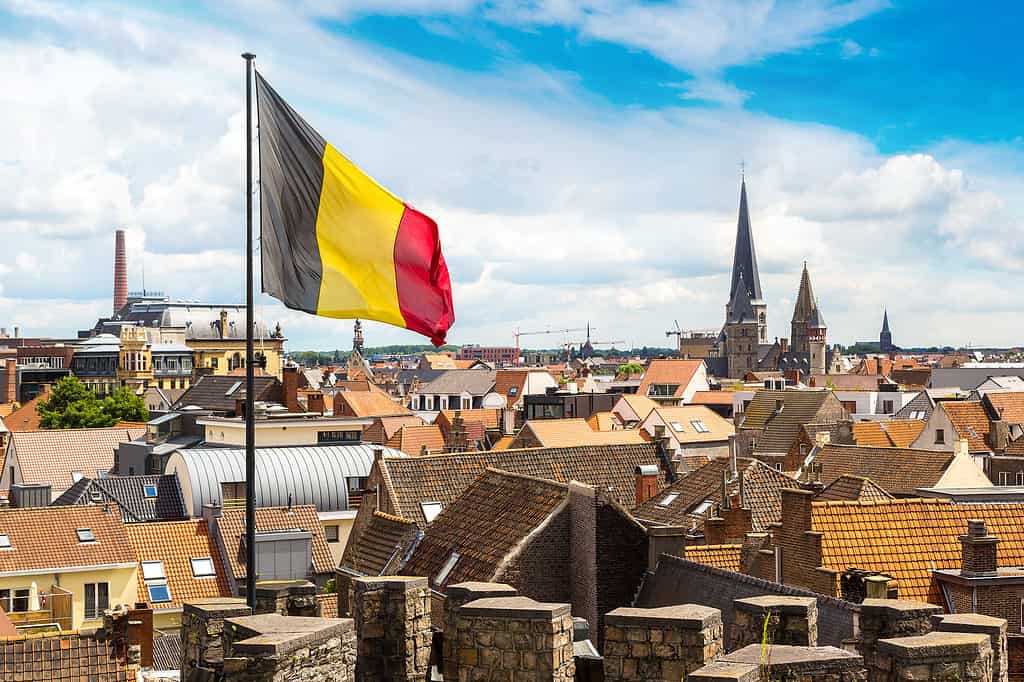
The Belgian flag design was inspired by the French Tricolor.
©Sergii Figurnyi/Shutterstock.com
8. Bosnia and Herzegovina
Bosnia and Herzegovina is one of the countries that became independent when Yugoslavia dissolved in the 1990s. After independence, it fought a violent civil war for 3 years in which hundreds of thousands of people died. The war ended with an agreement to share power between the three main ethnic groups: Bosniaks, Croats, and Serbs. The yellow triangle in the country’s flag stands for the three ethnic groups and roughly represents the shape of the country.
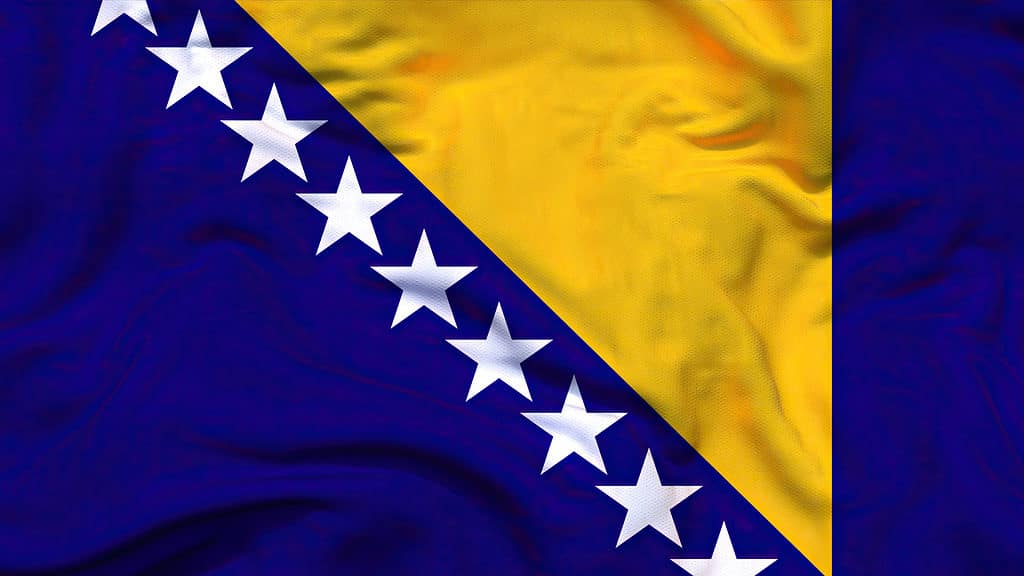
The flag of Bosnia and Herzegovina is intended to respect the three main ethnic groups and recalls the geographic shape of the country.
©iStock.com/EA
9. Bulgaria
The Bulgarian flag, which features three horizontal stripes of white, green, and red, symbolizes peace, love, and freedom with the white stripe. The green stripe represents the country’s agricultural wealth, and the red stripe symbolizes the country’s struggle for independence and military courage. The country officially adopted the Bulgarian flag when the country broke free from communist rule.
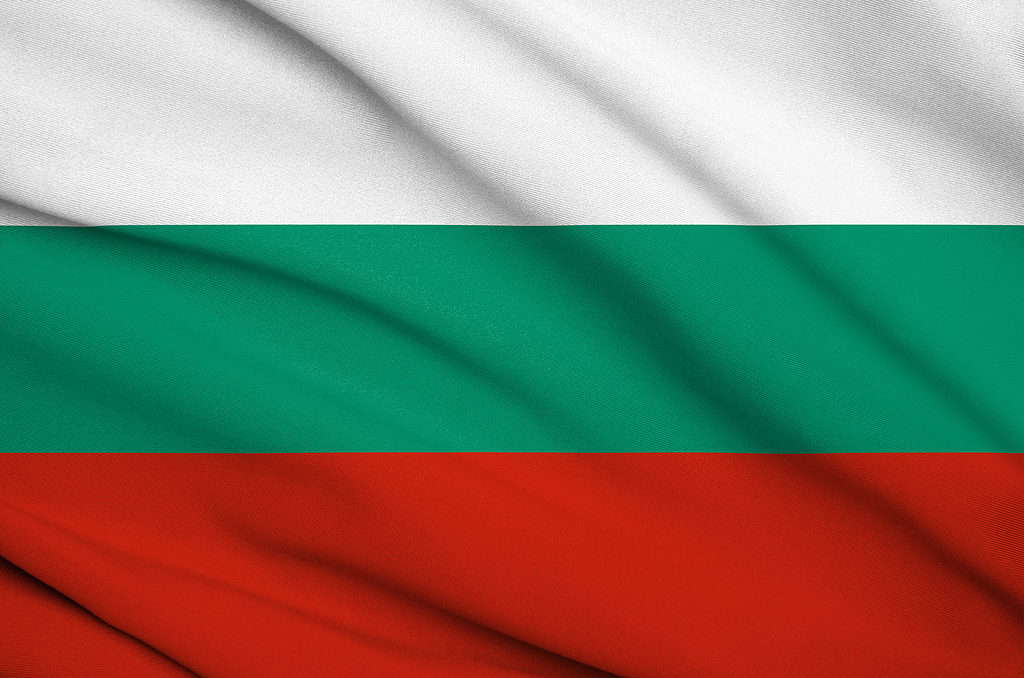
The flag of Bulgaria was adopted in 1989 to replace its previous communist flag.
©MriMan/Shutterstock.com
10. Croatia
Croatia is a former Yugoslavian country with a long coastline on the Adriatic Sea. Its flag has horizontal bands of red, white, and blue with the country’s coat of arms displayed in the center. The colors of the flag were inspired by the Tsarist-era flag of Russia because Russia was seen as an ally against the Austro-Hungarian Empire that dominated Croatia for centuries.
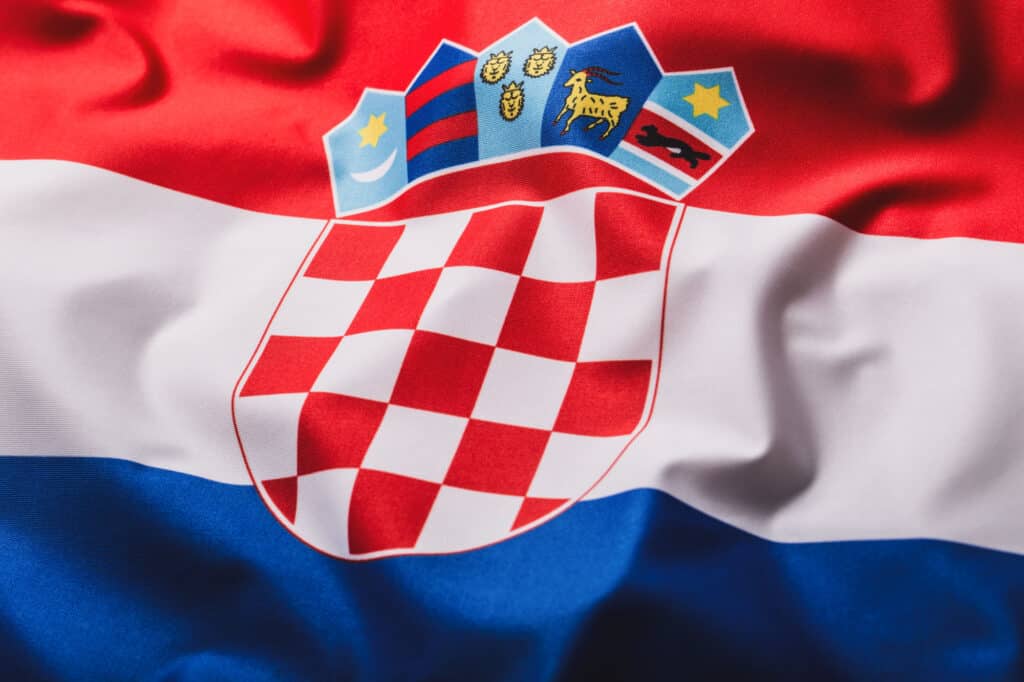
The colors of the Croatian flag were originally inspired by the Imperial flag of Russia, which was seen as a potential ally against Austria-Hungary.
©Marian Weyo/Shutterstock.com
11. Cyprus
The national flag of Cyprus shows a copper-colored map of the island. The island has rich copper deposits and its name is derived from the Sumerian word for copper. Cyprus has been divided since 1974 between the Greek and Turkish communities. The olive branches on the flag symbolize the hope for peace and reunification of the country.

Cyprus is divided between the Greek and Turkish communities. The olive branches on the flag express hope for peace and reconciliation.
©iStock.com/creisinger
12. Czech Republic
The Czech Republic and Slovakia became independent countries in 1992. The original flag of Czechoslovakia is still used by the Czech Republic. It features white over red horizontal bars with a blue triangle on the hoist side to differentiate it from Poland’s flag. Bohemia is traditionally represented by the color white or silver, symbolizing the sky. Red is the traditional color for Moravia, representing the blood shed for the state’s freedom. Slovakia is symbolized by the color blue, which is also associated with impartiality and sovereignty.
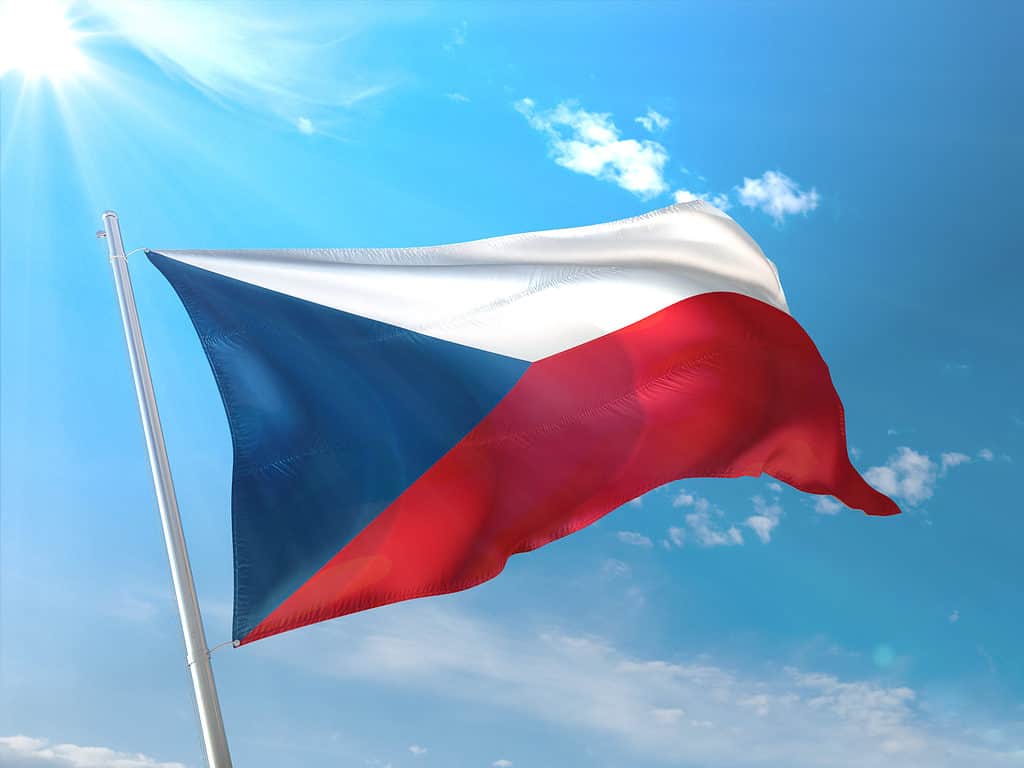
The Czech Republic uses the same flag as the former Czechoslovakia.
©NVM Design/Shutterstock.com
13. Denmark
Denmark’s flag, also known as the “Dannebrog,” is the oldest state flag still in use around the world. According to legend, it appeared as a sign from heaven to the Danish king in 1219. The blood-red flag features horizontal white cross, known as a “Nordic Cross,” that served as an inspiration for other regional flags.
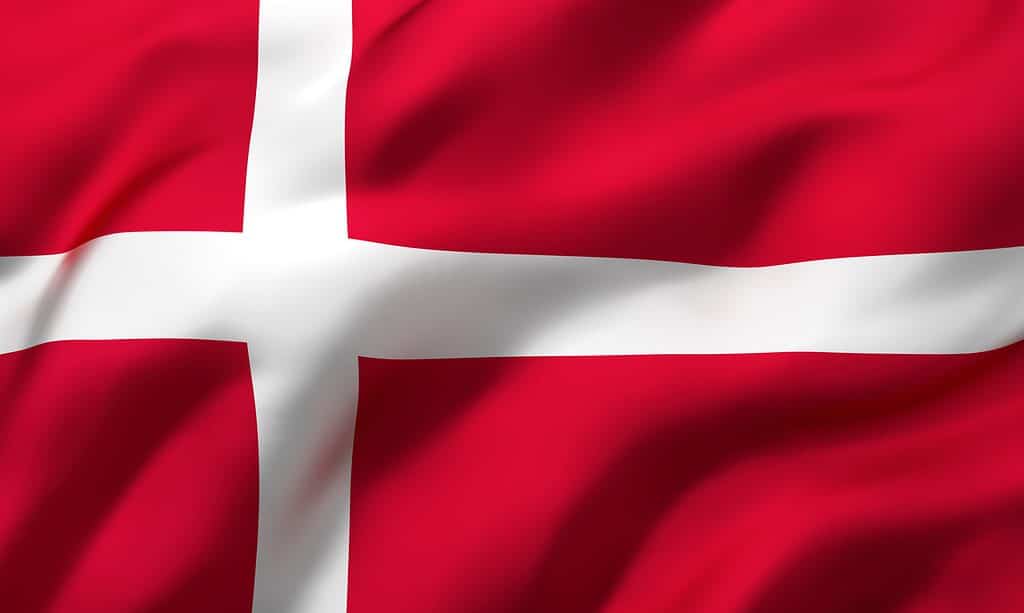
Denmark’s flag is the oldest state flag still in use by any country of the world.
©iStock.com/titoOnz
14. Estonia
Estonia’s flag was officially re-adopted on May 8, 1990. Its first use was in 1881 by the student corps “Vironia” and it became a national flag in 1918. The tricolor flag of blue, black, and white still exists and it is kept in the Estonian National Museum in Tartu. Blue represents Estonia’s loyalty, its skies, seas, and lakes. Black stands for the country’s soil and also its historic experiences of oppression. White recalls the country’s purity, its snow, and its freedom.
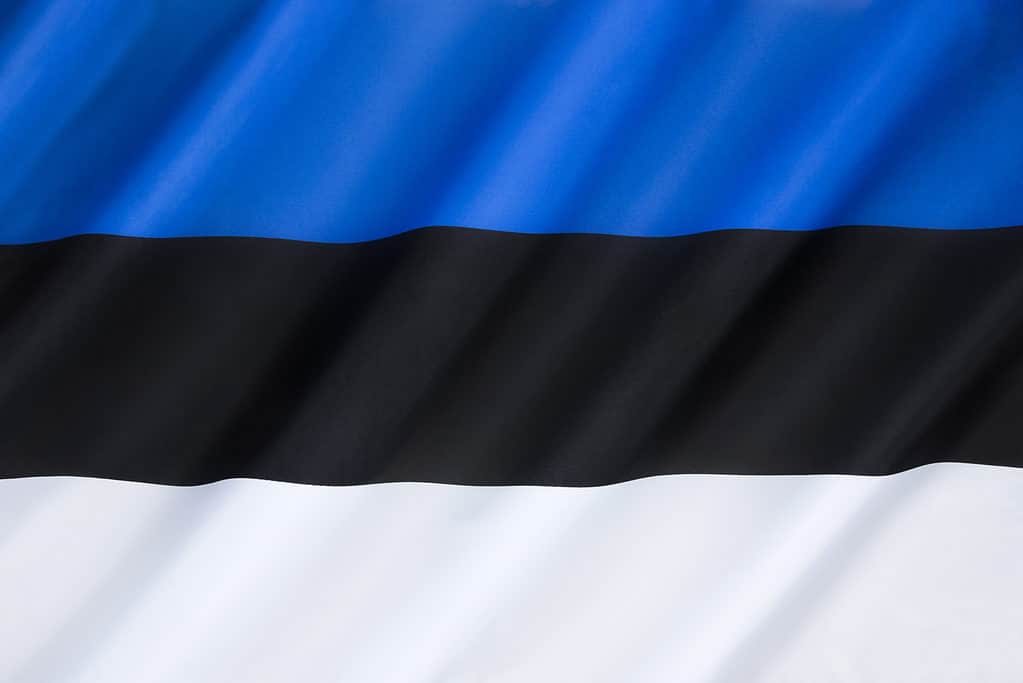
Estonia’s flag has three main colors, black, blue, and white. Each stripe represents something unique about the country and its history.
©Steve Allen/Shutterstock.com
15. Finland
Finland was at different times in history part of the Swedish or Russian empires, but it most recently became independent at the end of World War I. Its flag, like its Scandinavian neighbors, uses includes a cross in reference to the Christian heritage of these nations. In the case of Finland’s flag, blue was chosen to represent the country’s many thousands of lakes and the sky. The white background represents the snow that blankets the country in the winter.

An observation tower flies the Finnish flag among blue lakes and green forests in summer Finland.
©iStock.com/wmaster890
16. France
France’s Tricolor was adopted during the French revolution in 1794. The colors red, white, and blue were at the time popular with countries breaking free from autocratic control. They are intended to represent the ideals of the French Revolution: liberty, equality, and fraternity. However, these were also colors that were already a familiar part of French culture historically: blue and red were traditionally associated with the city of Paris and white represented the House of Bourbon.

The colors of the French flag represent the revolutionary ideals of liberty, equality, and fraternity.
©iStock.com/Olivier DJIANN
17. Georgia
Georgia, is a post-Soviet country in the Caucasus Mountains wedged between Turkey and Russia. Its flag is white and dominated by a large red cross that divides the flag into four equal quadrants. Each quadrant also has a red cross in the center of each. The design of this flag is based on a traditional 14th-century pattern.
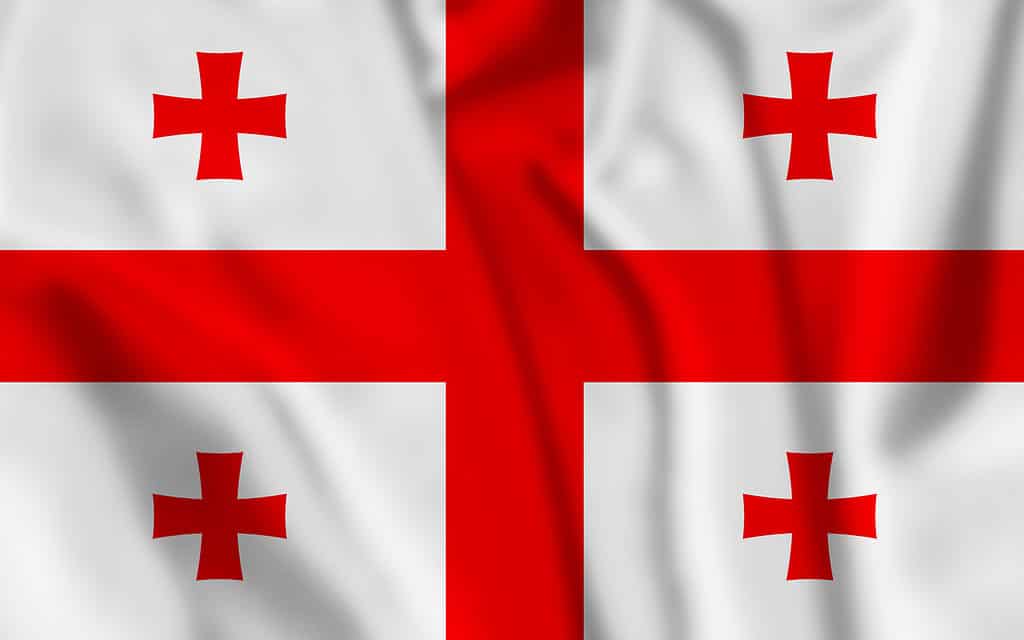
The flag of Georgia has a design that dates back to the 14th century.
©iStock.com/Alexandra Bykova
18. Germany
The flag of Germany is a tricolor of black, red, and yellow. Accounts of the origin and meaning of the colors differ. Some say it mimics the coat of arms of the Holy Roman Empire, a medieval confederation of Germanic states. Others say the colors were based on German military uniforms of the Napoleonic Wars. After World War II, this flag flew over West Germany, but after German reunification in 1990, it became the flag over both halves of the country.

The flag of West Germany became the flag of the reunited country when East Germany joined the West in 1990.
©Osman Bugra Nuvasil/Shutterstock.com
19. Greece
The flag of Greece, features a white cross and nine horizontal stripes. The cross honors the country’s Orthodox Christian heritage, and the stripes symbolize the Greek syllables of the phrase “Freedom or Death,” which was a Greek rallying cry during their independence movement.
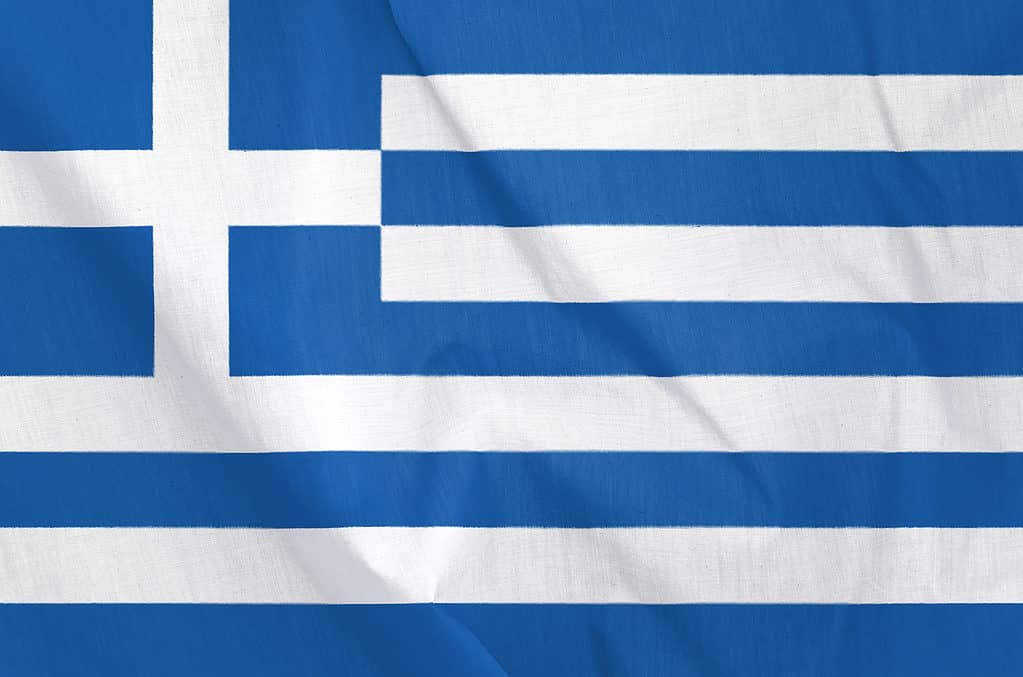
The stripes of the Greek flag represent the 9 syllables of the motto “Freedom or Death” in Greek.
©Naypong Studio/Shutterstock.com
20. Hungary
Located in central Europe, Hungary borders Slovakia, Ukraine, Romania, Serbia, Croatia, Slovenia, and Austria. Unlike their neighbors who speak mainly Slavic languages, Hungarians speak a Finno-Ugric language related to Estonian and Finnish. The country’s flag is a tricolor of red, white, and green, representing strength, faithfulness, and hope.

The Hungarian flag is a horizontal tricolor of red, white, and green bands.
©Savvapanf Photo/Shutterstock.com
21. Iceland
The flag of Iceland features the Nordic Cross design, popular in Scandinavian countries. The colors of the flag: blue, white, and red, represent the natural features of the country: blue for the sea, white for snow and glaciers, and red for volcanic lava. The design of the flag is similar to the flag of Norway, showing their close historical ties, but with the colors reversed.

The design of Iceland’s flag reflects its historical and cultural roots. Its colors reflect the natural features of the country.
©iStock.com/EA
22. Ireland
Ireland was a part of the British Empire from 1801-1922. Before gaining independence, British authorities partitioned Northern Ireland from the rest of the country and retained it as part of the United Kingdom. The simple tricolor design of the country’s flag carries deep symbolism. The green band represents the Irish Catholic community. Orange is the signature color for Protestants in the region. White is symbolic of the hope for peace between the two.
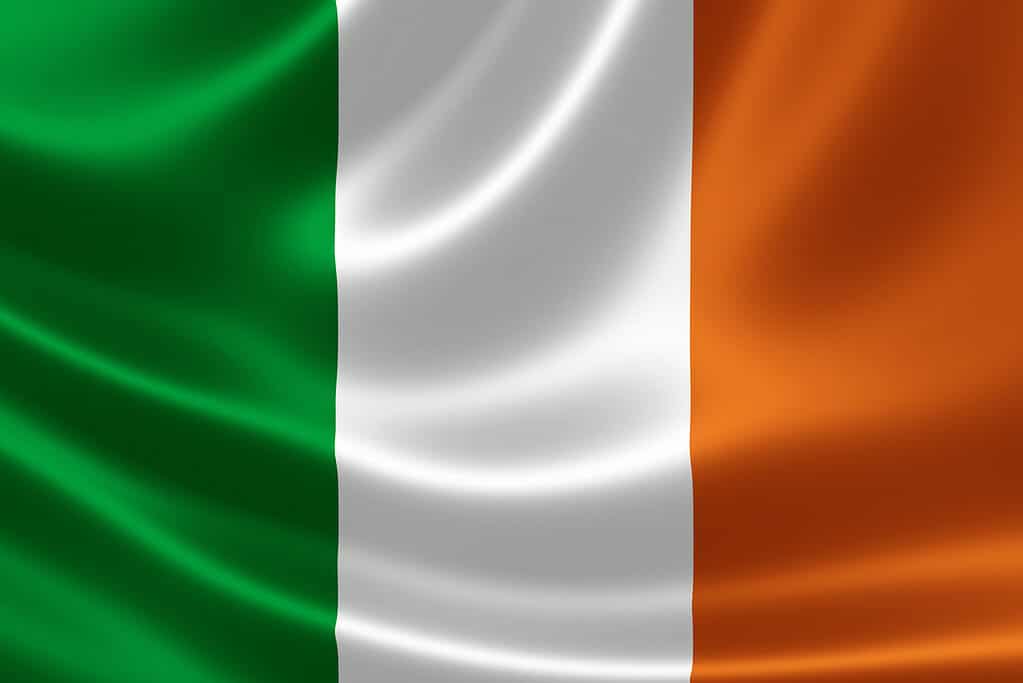
The colors of Ireland’s flag stand for the Catholic and Protestant communities and the hope for peace between them
©iStock.com/ronniechua
23. Italy
Arguably, with its history as the seat of the Roman Empire, Italy is the birthplace of Europe. The flag of Italy is a tricolor of vertical bands of green, white, and red. Green represents hope; white – loyalty; and red – the bloodshed that brought the country to unity.

Italy has been the site of much of Europe’s history. Its flag is a tricolor of green, white, and red.
©Philipp Dase/Shutterstock.com
24. Kazakhstan
Like Russia and Turkey, most of Kazakhstan’s land area is a part of Asia; however a considerable portion of Western Kazakhstan ventures west of the Ural Mountains. The State Flag of Kazakhstan is a blue rectangular flag with the image of a sun in the center, a soaring steppe eagle underneath, and national ornamental patterns along the flagstaff. The blue color symbolizes the ancient Turkic people’s devotion to the sky as their God, representing the pure sky, peace, and prosperity, and the unity of the country. The sun symbolizes wealth and abundance, life and energy, and the steppe eagle represents power, insight, and generosity. The national ornament along the flagstaff represents the art and cultural traditions of the people of Kazakhstan.
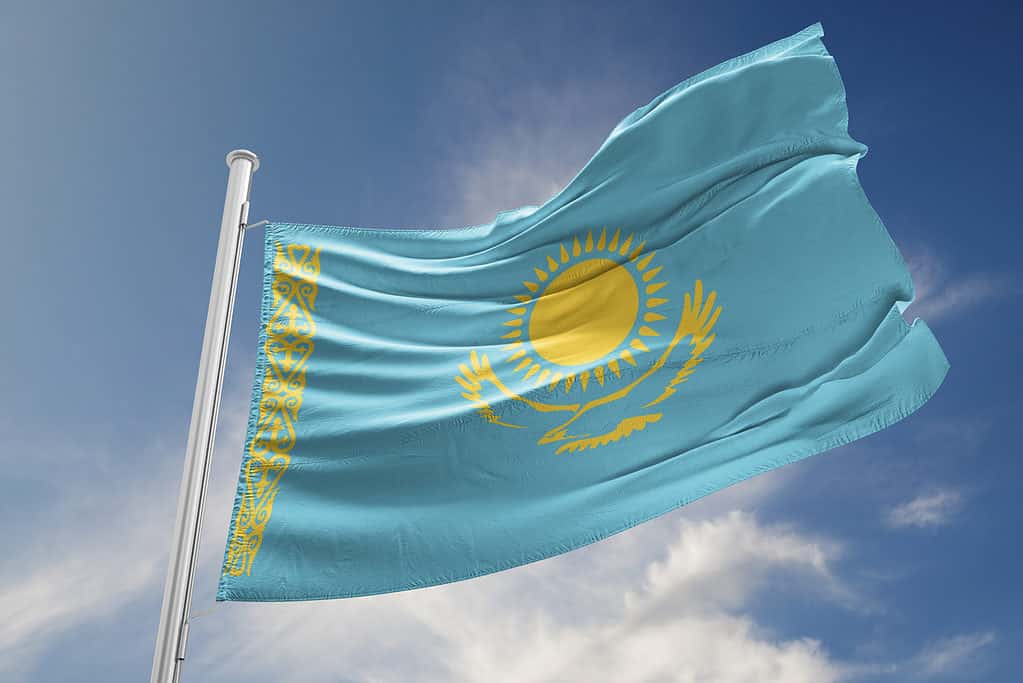
Kazakhstan’s flag is predominantly blue, symbolic of the vast sky over this land of rolling steppes.
©iStock.com/HStocks
25. Kosovo
Kosovo is a small country in the Balkan region of southeastern Europe that borders Montenegro, Serbia, North Macedonia, and Albania. 90% of the population of Kosovo is Albanian. It was a part of Serbia, but as a result of intense ethnic fighting, declared its independence in 2008. The new country’s flag includes a map of Kosovo on a blue field, with 6 stars to honor its 6 main ethnic groups.
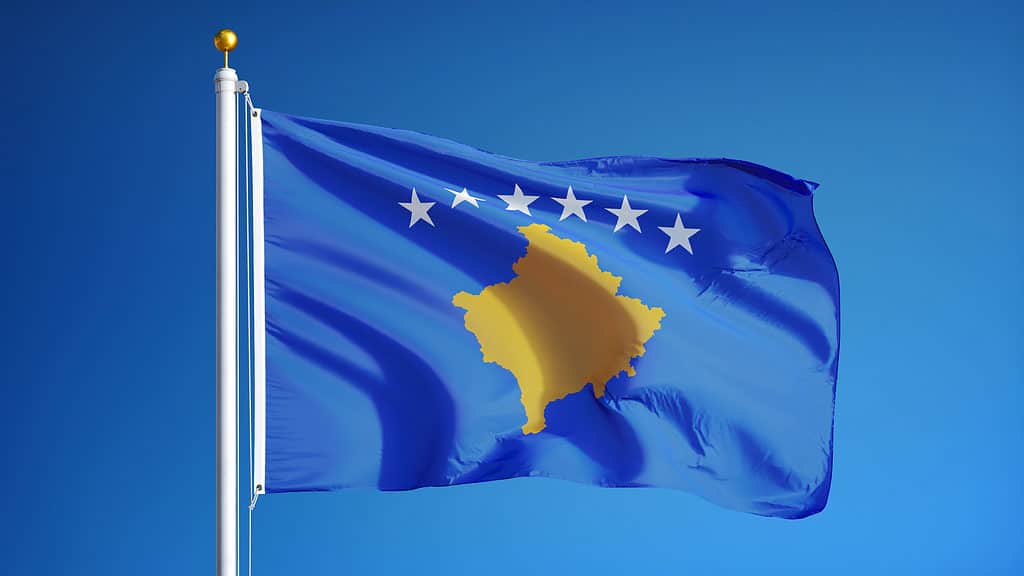
The flag of Kosovo includes a map of the country and stars representing its six main ethnic groups.
©railway fx/Shutterstock.com
26. Latvia
Latvia is a Baltic country bordering Estonia, Russia, and Lithuania. Its flag design dates back to the 13th century. It was officially re-established in 1990 when Latvia succeeded in achieving independence from the Soviet Union. To differentiate it from the Austrian flag, the flag features a 2:1:2 ratio and a specific shade of red known as “Latvian red.” Latvians consider this color symbolic of their readiness to give their lives to defend their freedom.

Latvia’s flag is similar to Austria’s but has different dimensions and a special shade of red known as “Latvian red.”
©iStock.com/Ingus Kruklitis
27. Liechtenstein
Liechtenstein is a very small Alpine principality located between Switzerland and Austria. It is famous for medieval castles and charming villages connected by trails. The flag of Liechtenstein features two horizontal stripes of blue and red, with a gold crown in the top left corner. By coincidence, Liechtenstein’s flag has the same blue and red horizontal banners as Haiti’s, but Liechtenstein placed a crown in the top hoist-side corner, while Haiti’s has the country’s coat of arms in the center.
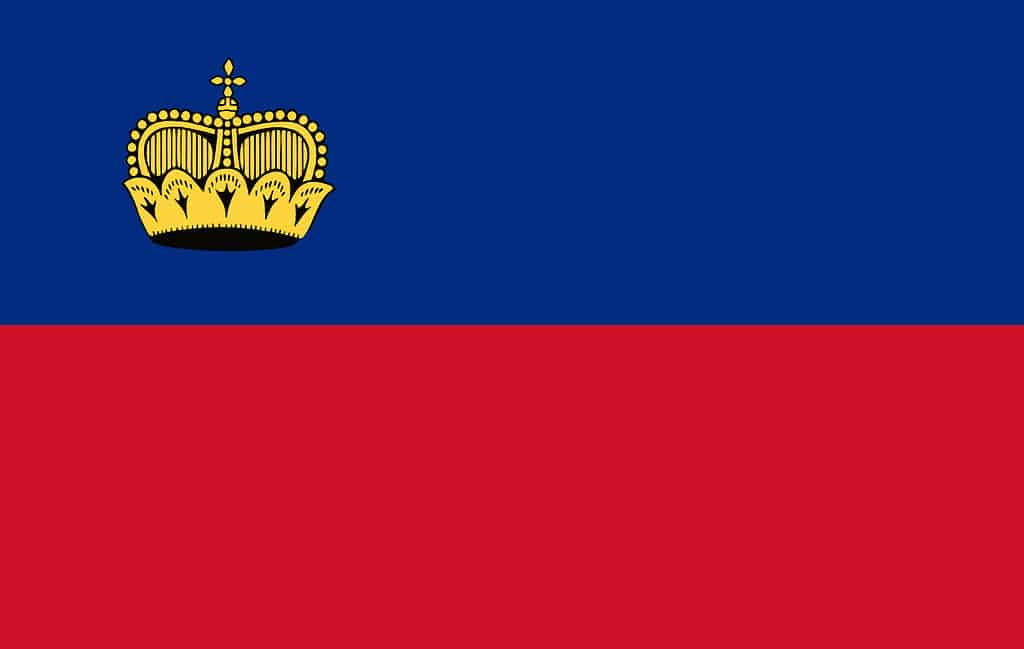
The flag of Liechtenstein features two horizontal stripes of blue and red, with a gold crown in the top left corner.
©mars-design/Shutterstock.com
28. Lithuania
Lithuania is a small Baltic country with a long history. It shares borders with Latvia, Poland, and the Kaliningrad enclave of Russia, which is separated from the rest of Russia by Lithuanian and Polish territory. Lithuania won independence from the Soviet Union in 1990. Its flag is a horizontal tricolor of yellow, green, and red. As a predominantly agricultural and rural country, on its flag, Lithuania honors its wheat fields and forests with the colors yellow and green. Red asserts the courage, hope, and freedom of the country.
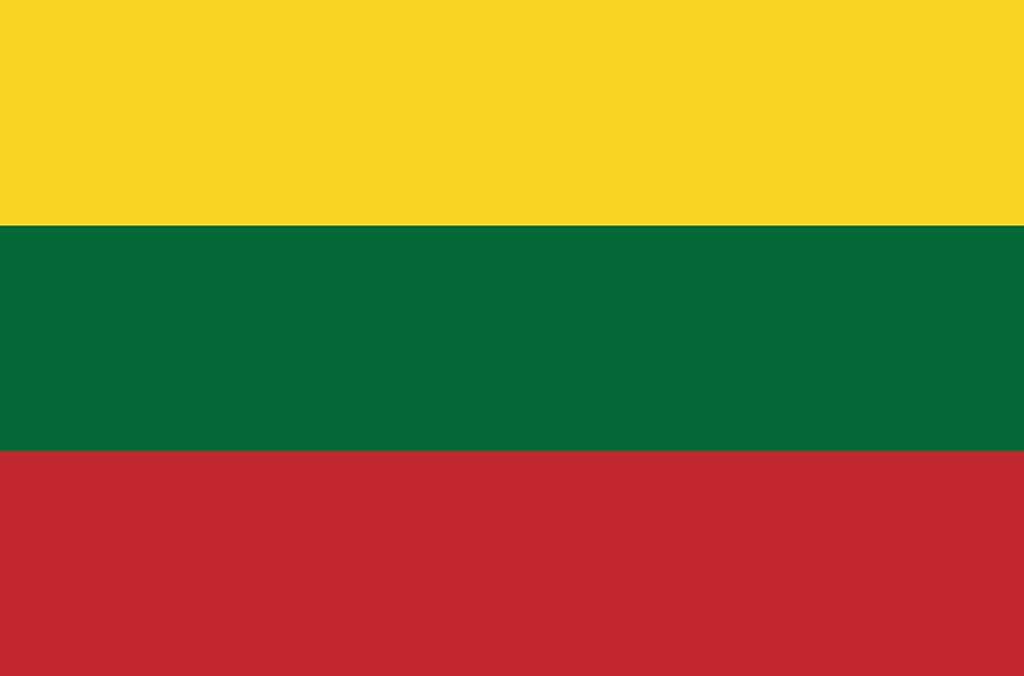
The flag of Lithuania is a distinctive tricolor of yellow, green, and red bands.
©DHAYAWATHI/Shutterstock.com
29. Luxembourg
The flag of Luxembourg features a combination of red, white, and blue colors dating back to the 13th century and the Grand Duke’s coat of arms. Luxembourg was once ruled by the Netherlands as part of a united kingdom with Belgium, but became independent in 1815. Interestingly, after World War II, Belgium the Netherlands, and Luxembourg co-founded Benelux, a free trade zone that became the nucleus of today’s European Union.
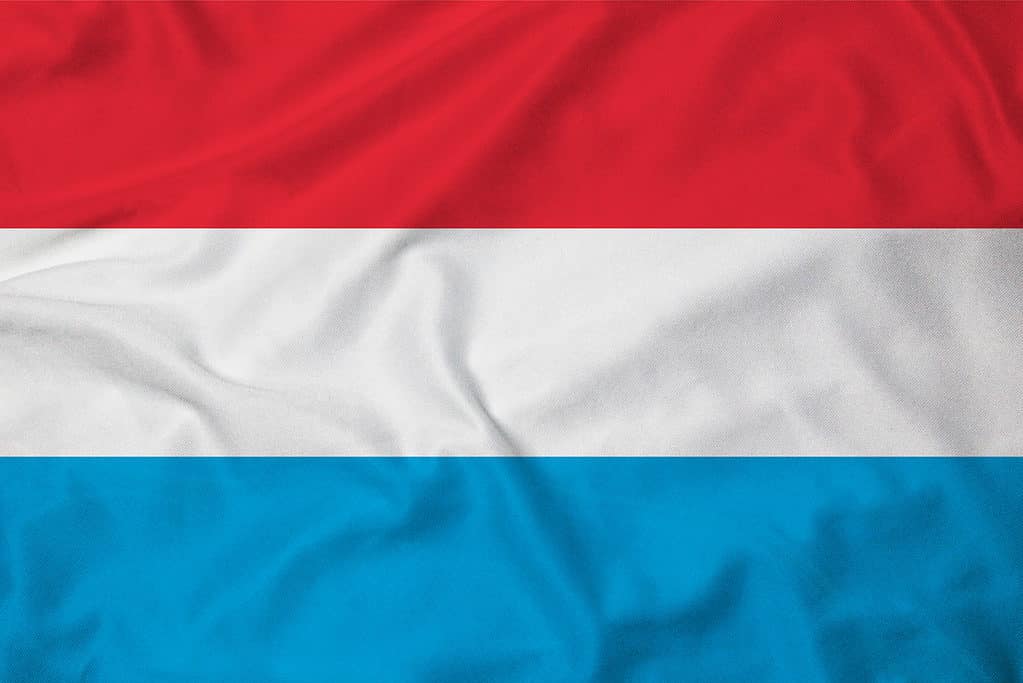
The colors of the flag of Luxembourg were in use there dating back to the 13th century.
©iStock.com/Royal Graphics
30. Malta
The current flag of Malta was adopted in 1964 and features the traditional Maltese colors red and white. The flag also features the George Cross in the upper hoist-side corner, outlined in red. The cross was presented as an honor to Malta by King George VI of the United Kingdom as a recognition of the islanders’ courage during World War II.

The flag of Malta includes the George Cross, presented by the King of England to honor the bravery of the Maltese people during World War II.
©Anna Marin N/Shutterstock.com
31. Moldova
The flag of Moldova, which was officially adopted on May 12, 1990, reflects the country’s historical association with Romania. The flag features similar shades of red, yellow, and blue to the Romanian flag. The central shield on the flag features a golden eagle with a cross in its beak, holding an olive branch symbolizing peace.
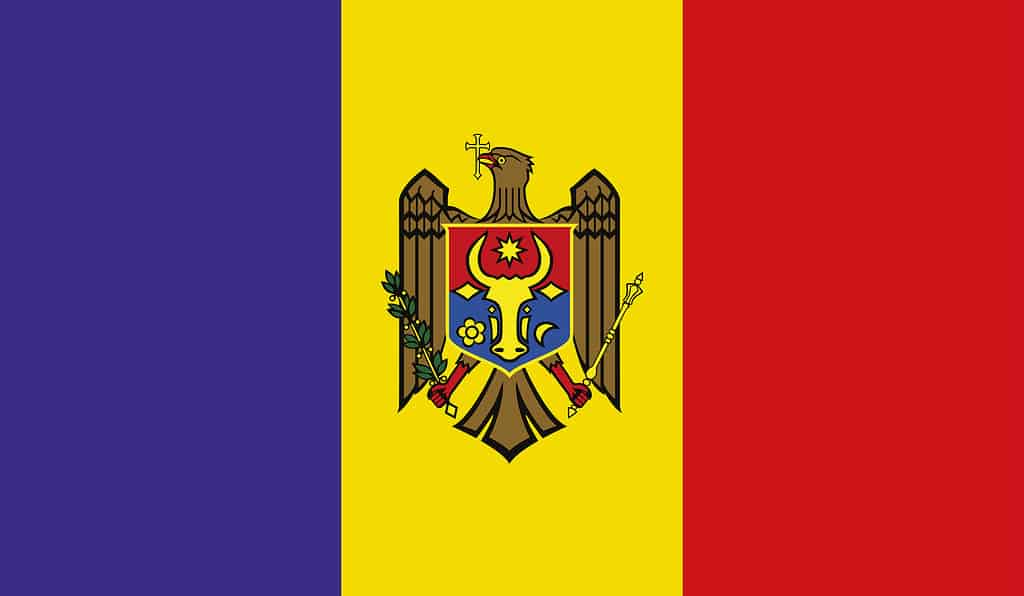
The flag Of Moldova is similar to that of Romania, in honor of the long historical connection between the two countries.
©iStock.com/Burak Ceyhan
32. Monaco
Monaco is a principality located on the Riviera coast, a region it shares with France and Italy. This small country became especially famous after the American actress Grace Kelly became royalty after marrying the country’s ruling prince. The flag of Monaco features two horizontal bands of red and white, which have been the heraldic colors of the House of Grimaldi since at least 1339. It is identical to the flag of Indonesia but has no historical connections to it.
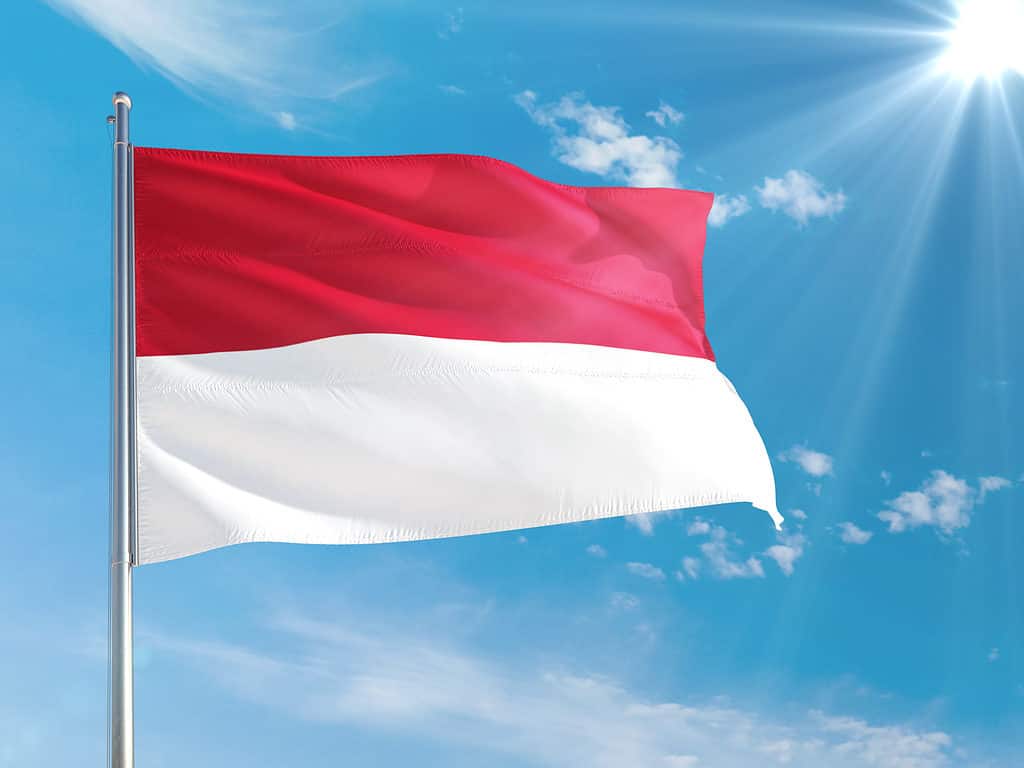
The flag of Monaco is identical to that of Indonesia, although the countries have no historical connection.
©Black Pearl Footage/Shutterstock.com
33. Montenegro
Montenegro is one of several countries that became independent after the collapse of Yugoslavia. Its flag is a red banner with the country’s coat of arms in the center. The double-headed eagle wearing a crown conveys the close connection between the church and the state in a country where 72% of the population is Eastern Orthodox. The shield at the center displays a lion that represents the “Lion of Judah,” a biblical reference to Christ.
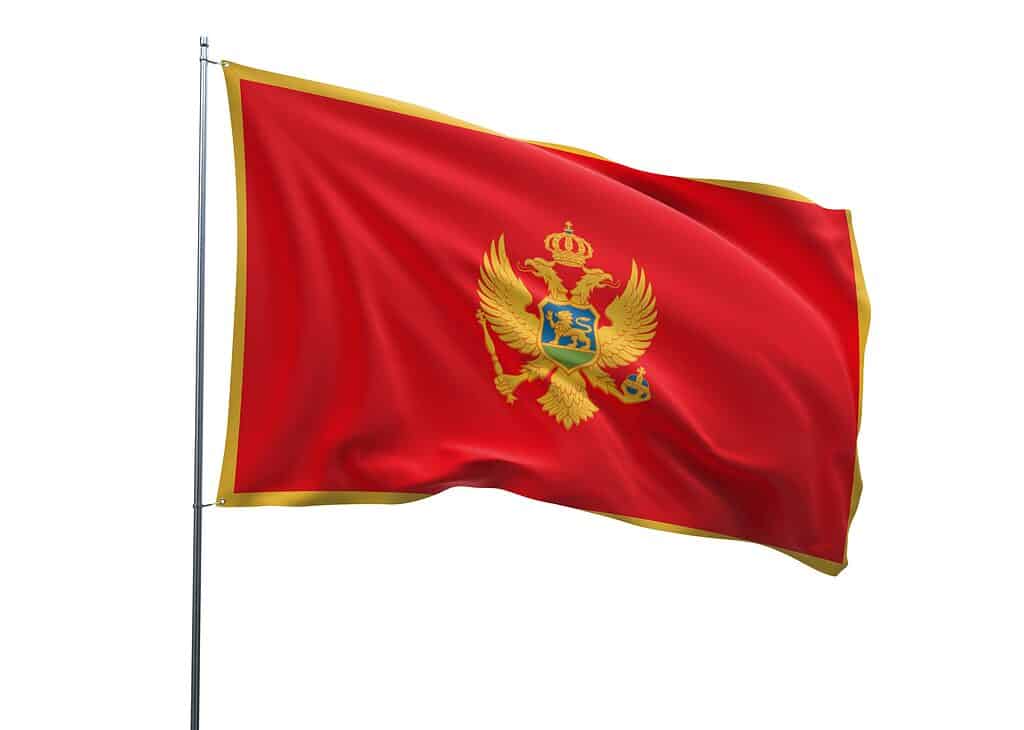
The double-headed eagle in the flag of Montenegro represents the close association between church and state.
©Firoz_Designs/Shutterstock.com
34. Netherlands
The flag of the Netherlands is a tricolor of red, white, and blue. Red replaced the orange color in the 17th century due to the instability of the orange dye. The flag is the oldest tricolor flag still in national use.
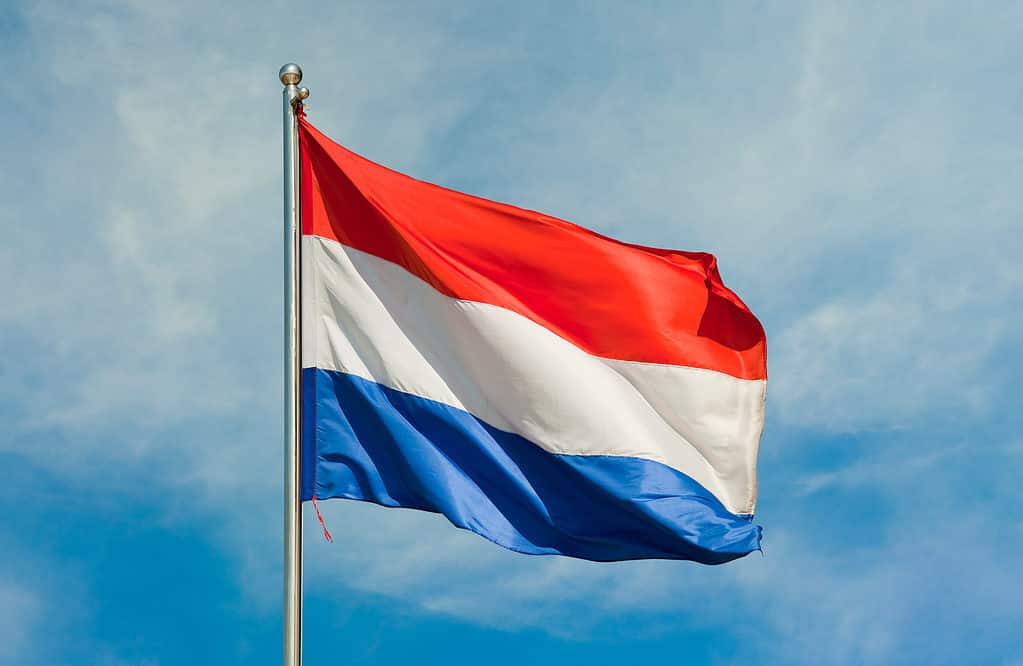
In the past, the Dutch flag had orange, white, and blue stripes, but the orange dye was unstable, so it was replaced with red.
©iStock.com/macky_ch
35. North Macedonia
The flag of North Macedonia adopted in 1995, features a rising yellow sun symbolizing “the new sun of liberty,” as evoked in the Macedonian national anthem, “Today Over Macedonia.”
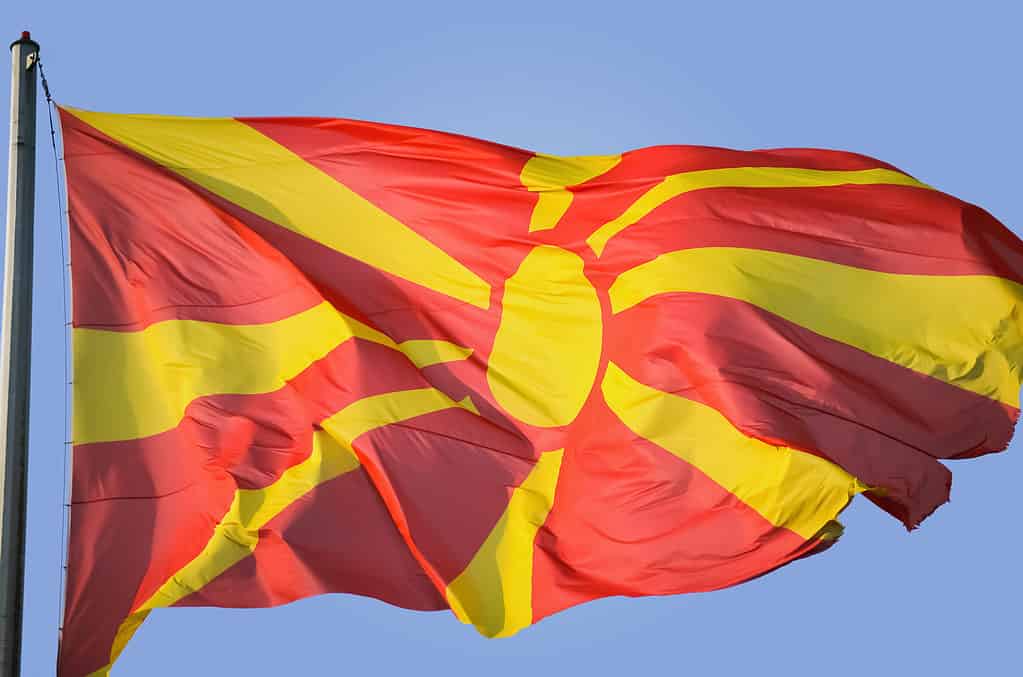
The rising sun on the flag of North Macedonia is drawn from the country’s national anthem.
©benjaminac/Shutterstock.com
36. Norway
The flag of Norway is red with a blue horizontal cross on a larger white cross. The Norwegian flag is similar to that of Denmark and other regional flags. Crosses are a typical feature of Scandinavian flags, recalling these countries’ Christian cultural heritage.

Horizontal crosses are a common feature of Scandinavian flags. They honor the Christian heritage of these northern European countries.
©Tatohra/Shutterstock.com
37. Poland
The flag of Poland features the colors red and white, which have been national colors since the late 18th century. White in the flag symbolizes purity and red symbolizes love, echoing Catholic values and symbolism. According to legend, the first settlers of Poland saw a white eagle landing in front of a red sunset and took it as a sign to settle in present-day Gniezno.
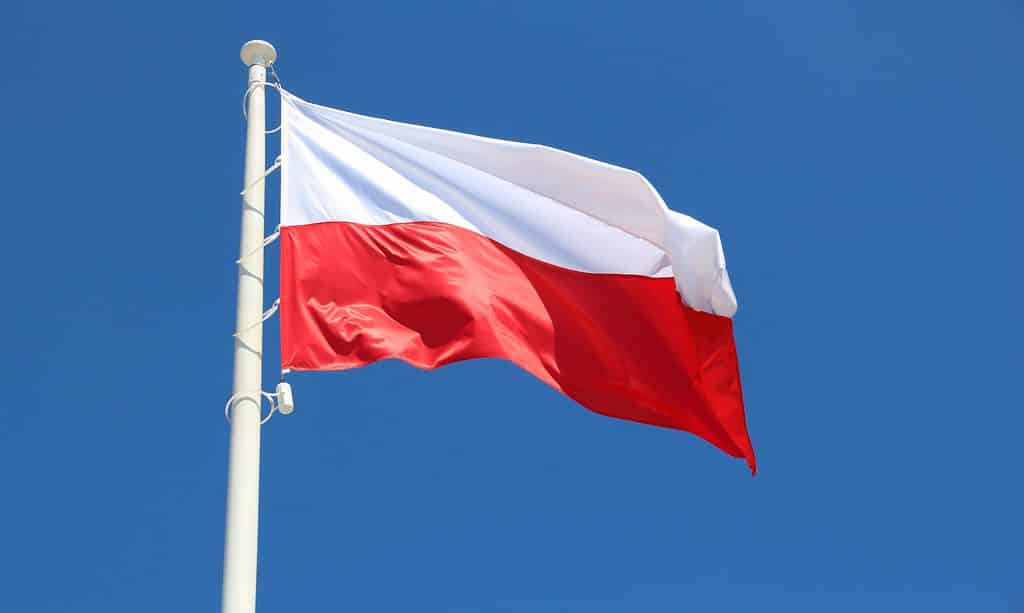
The colors of the Polish flag are inspired by a legend about a sign seen by the first settlers in Poland.
©iStock.com/tupungato
38. Portugal
Portugal’s flag divides into green and red horizontal banners with the national coat of arms superimposed in the middle at the border between the two colors. The green color represents hope and the red represents the blood of those who died for the country’s freedom.

Portugal’s red and green flag highlights the country’s national coat of arms.
©iStock.com/Oleksii Liskonih
39. Romania
The flag of Romania is a vertical tricolor of blue, yellow, and red, with the colors being of equal width. The flag featured a communist symbol during its years as part of the Soviet-dominated Warsaw Pact. During the Romanian revolution of 1989, rebels flew the flag with a hole in the center where the rebels had removed the symbol. Today, the flag flies symbol-free and hole-free, using traditional Romanian national colors dating back to the 19th century.
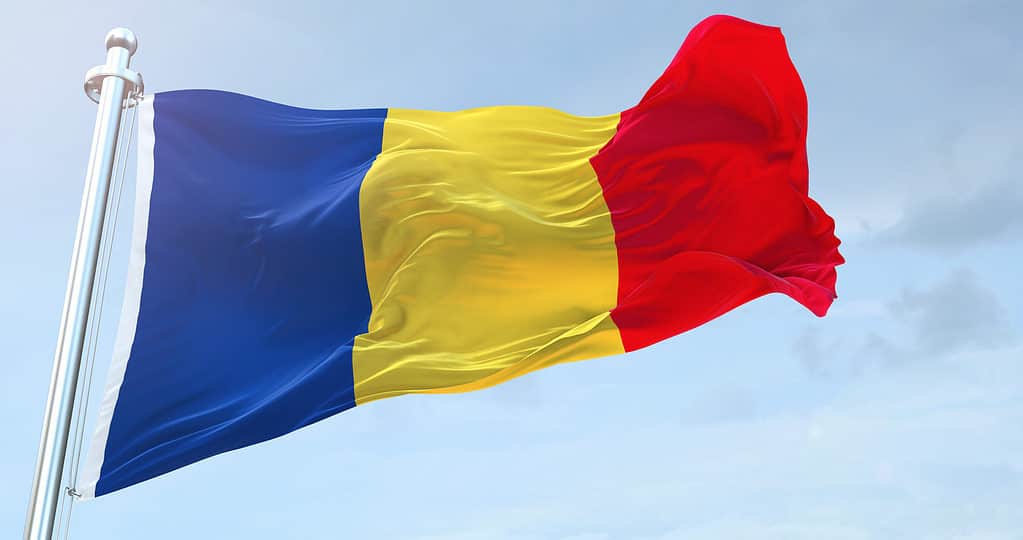
Under communism, the Romanian flag featured a communist symbol that was cut out by rebels during the 1989 revolution.
©iStock.com/EA
40. Russia
The flag of Russia was officially adopted on August 22, 1991, soon after the collapse of the Soviet Union. The flag is composed of three equal horizontal bands of white, blue, and red, which are considered Pan-Slavic colors. The traditional interpretation of these colors in Russia historically was as follows: white stands for nobility; blue for faithfulness and honesty; and red for courage, generosity, and love.

The red, white, and blue of the Russian flag are considered Pan-Slavic colors.
©Negro Elkha/Shutterstock.com
41. San Marino
San Marino, a small nation surrounded by the territory of Italy, has equal horizontal bands of white and light blue with the national coat of arms displayed in the center. White and blue are inspired by the clouds and sky over this mountainous country.
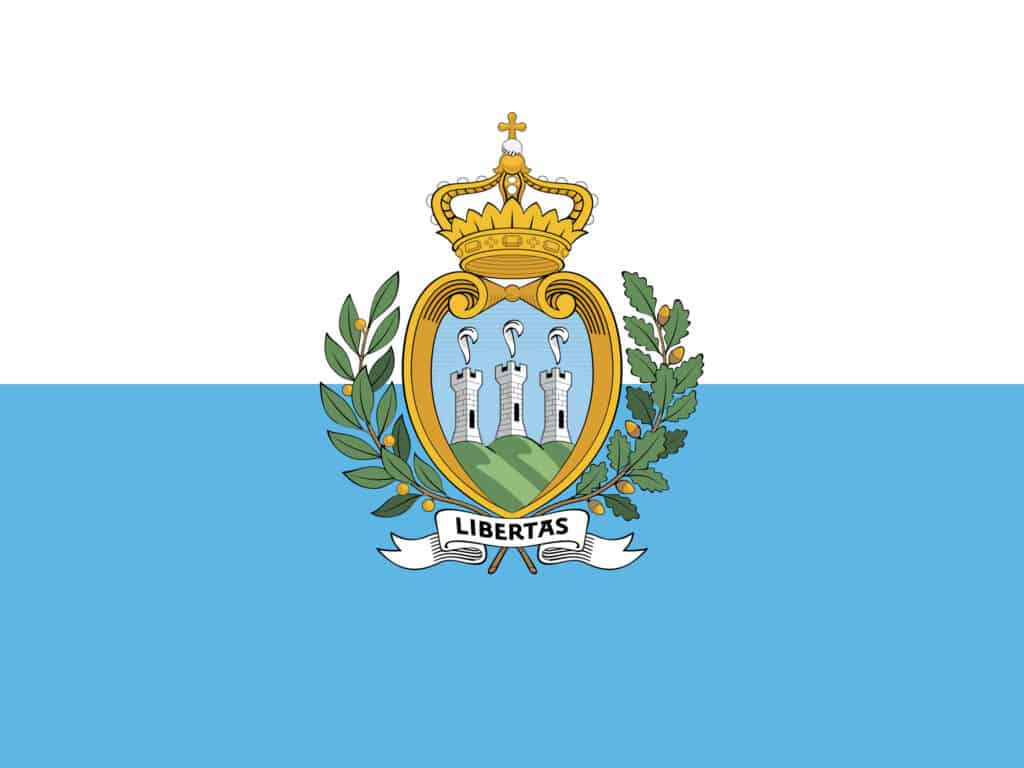
The white and blue of the flag of San Marino are inspired by the clouds and sky over this mountainous country.
©iStock.com/de-nue-pic
42. Serbia
The flag of Serbia is similar in colors and design to the Russian flag, a country with which it shares close historical and cultural ties. Red, white, and blue are popular in many eastern European countries and are considered signature Pan-Slavic colors. In the center is the coat of arms of Serbia, depicting Saint Sava, a national religious hero.

Serbia’s flag features red, white, and blue, colors popular in the Slavic countries of Eastern Europe.
©tatohra/Shutterstock.com
43. Slovakia
Slovakia is a country that declared its independence from Czechoslovakia in 1993 in a peaceful division of the country sometimes called the Velvet Divorce. Like many other east European countries, its flag features the colors red, white, and blue. The shield on the flag features three hills representing mountain ranges in the country, and the white cross is a symbol of the country’s Christian faith.
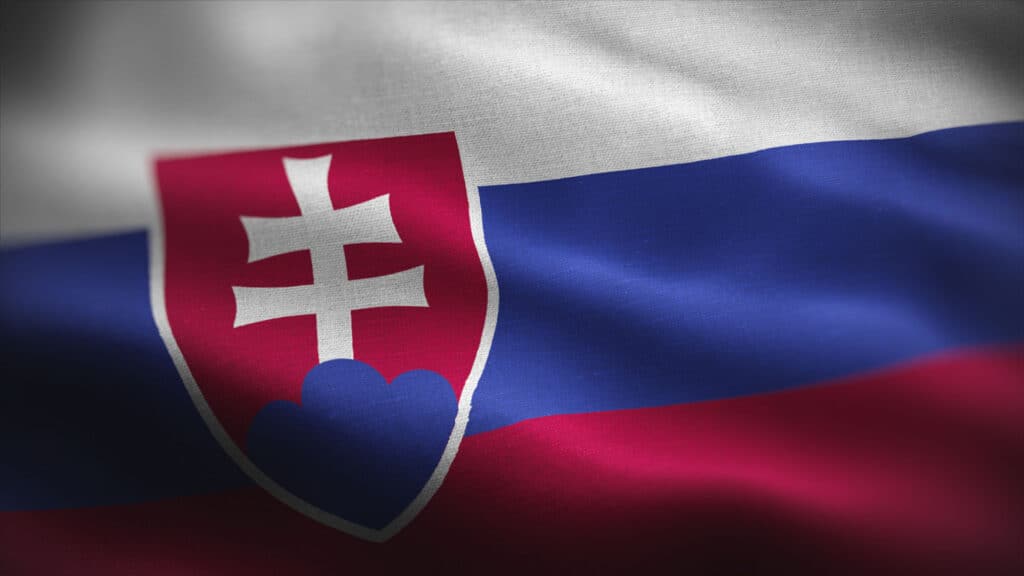
The shield on the Slovakian flag alludes to three mountain ranges in the country and the Christian faith of many of its citizens.
©Tatohra/Shutterstock.com
44. Slovenia
Slovenia, an emergent country from the former Yugoslavia, adopted a flag of white, blue, and red tricolor stripes. The coat of arms features three gold stars and the Alps, which are a dominant feature of the country’s landscape. The curved blue lines across the bottom of the mountains represent Slovenia’s access to the Adriatic Sea – something the country is quite proud of, as it only has about 30 miles of seashore.
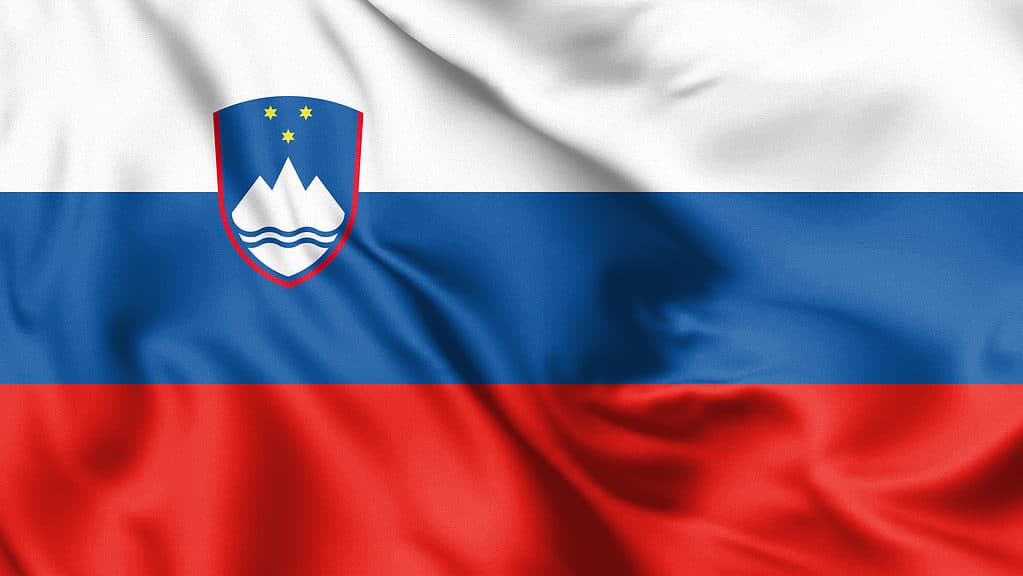
Slovenia is a mountainous country with only 30 miles of seashore. These geographic features are displayed proudly on the country’s flag.
©J_UK/Shutterstock.com
45. Spain
Red and yellow are the dominant colors of the flag of Spain. Red stands for strength and courage and yellow symbolizes generosity. There is also a historic connection between these colors. They, and the coat of arms on the flag, come from the symbols of the precursor kingdoms of Spain. King Ferdinand II and Queen Isabella united them in the 15th century. These, of course, were the patrons of Christopher Columbus who commissioned him to sail across the Atlantic and unexpectedly discovered the New World.
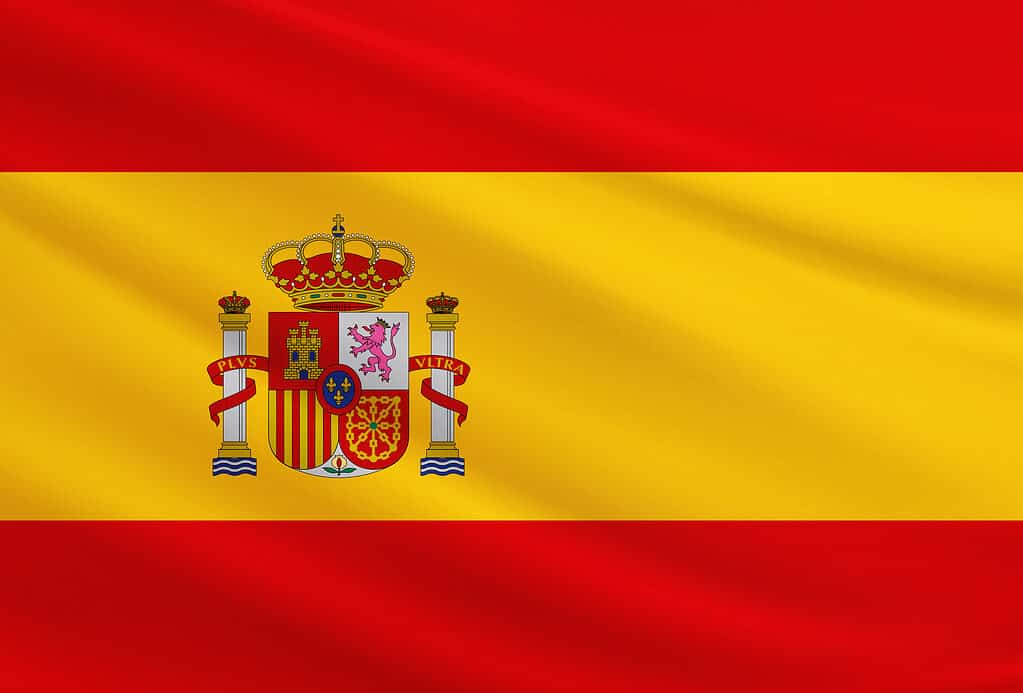
The colors and coat of arms on the Spanish flag were drawn from the national emblems of smaller precursor kingdoms of united Spain.
©Osman Bugra Nuvasil/Shutterstock.com
46. Sweden
The flag of Sweden features a blue field with a yellow Nordic Cross. The design imitates the Danish flag, and the colors yellow and blue come from the Swedish national coat of arms.

The Swedish flag, like that of its Scandinavian neighbors, features the Nordic Cross.
©iStock.com/tt
47. Switzerland
The flag of Switzerland is a red square with a simple white cross in the center. It is one of only two square flags, the other being that of Vatican City. When the colors of the Swiss flag invert, with a red cross on a white field, it represents the International Committee of the Red Cross, an important, world-recognized humanitarian organization founded by Henry Dunant of Switzerland. Because Switzerland has a global reputation for strict neutrality, this connection enhances acceptance of the Red Cross in many countries of the world for relief efforts.
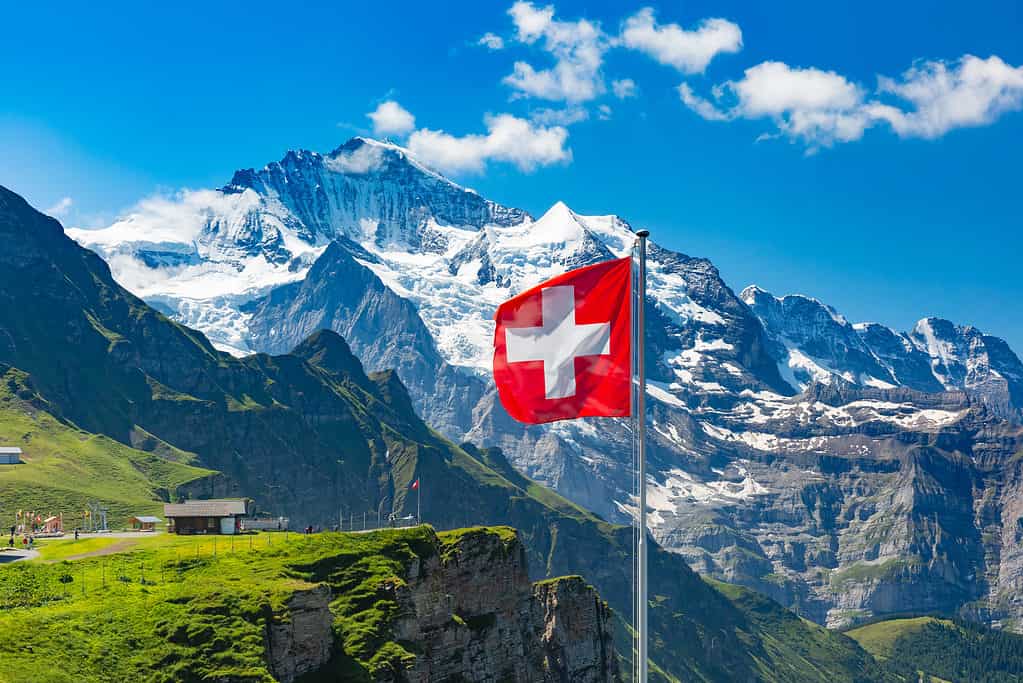
The Swiss flag is a red square with a simple white cross in the center.
©kavalenkava/Shutterstock.com
48. Turkey
Although most of Turkey is located on the Asian continent, part of it is located in southeastern Europe. Thus, like Russia and Kazakhstan, Turkey is both a European and an Asian nation. Turkey’s flag features a crescent moon and star, historic Islamic symbols important in Turkish culture.

The Turkish flag features a white crescent and a white star on a red background.
©iStock.com/ronniechua
49. Ukraine
Ukraine became independent from the Soviet Union in 1991. The simple and easily recognizable design of Ukraine’s flag symbolizes the wide blue sky over golden wheat fields. It’s an appropriate symbol for a country that has some of the most fertile farmland in the world. Its color choice is unique among the flags of Europe.
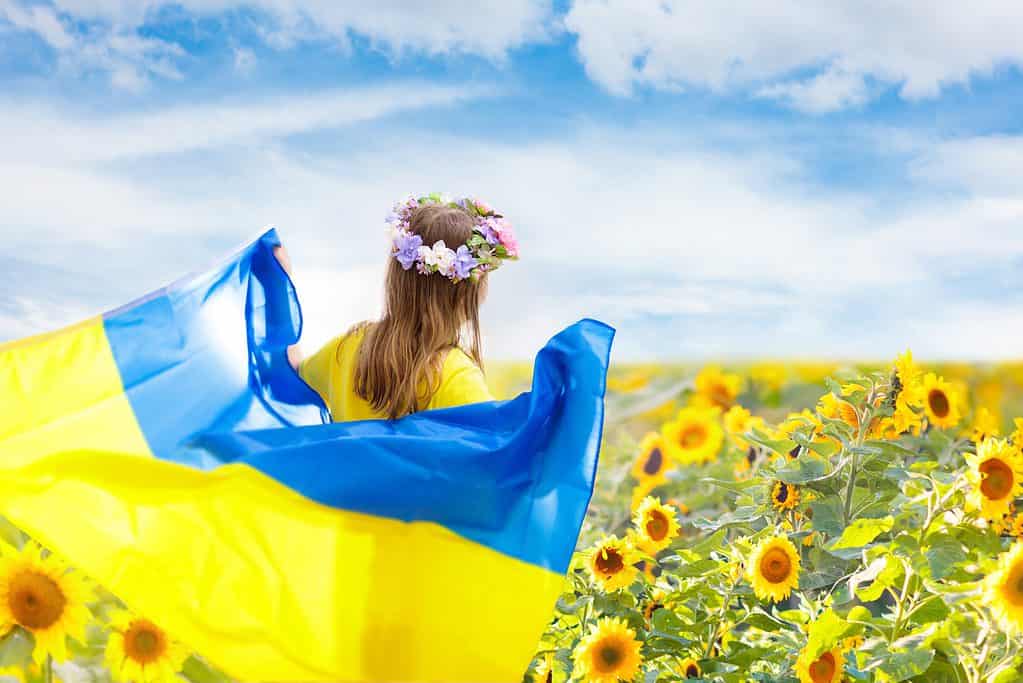
The colors of the Ukrainian flag symbolize the blue sky over yellow fields ready for harvest.
©FamVeld/Shutterstock.com
50. United Kingdom
The United Kingdom‘s flag, also known as the Union Jack, may be one of the most recognizable flags of Europe. It was created in 1800 when the Kingdom of Great Britain and the Kingdom of Ireland joined to form the United Kingdom of Great Britain and Ireland. It combines the crosses of England, Ireland, and Scotland’s patron saints. Wales, another part of the UK, is not graphically represented on the flag.

The flag of the United Kingdom includes design elements honoring England, Scotland, and Ireland.
©iStock.com/titoOnz
51. Vatican City
On the flag of Vatican City, which is a micronation inside the city of Rome, you’ll notice two vertical stripes of yellow and white. In the white band are symbolic representations of the crossed keys of Saint Peter and the Papal Tiara. It is unique, as one of only two square-shaped national flags in the world. The other one is Switzerland’s flag.
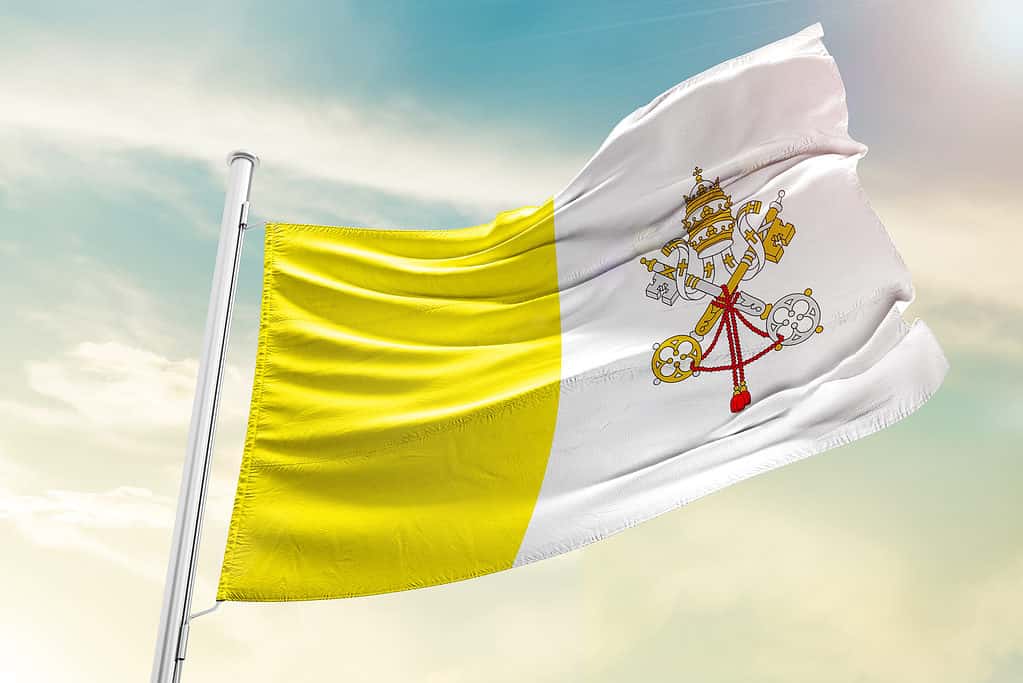
The Vatican City flag includes the crossed keys of Saint Peter and the Papal tiara.
©em_concepts/Shutterstock.com
The photo featured at the top of this post is © Steve Allen/Shutterstock.com
Thank you for reading! Have some feedback for us? Contact the AZ Animals editorial team.






